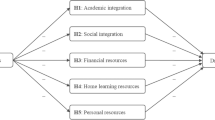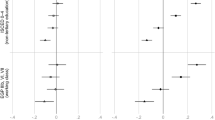Abstract
Dropping out of higher education is a prevalent phenomenon in Germany—about every fourth college student does not graduate—that affects educational returns to a considerable degree. Therefore, dropouts are a topic of major interest in the higher education stage of the NEPS. With the NEPS data, it is possible to study dropouts from higher education with large-scale, nationwide, representative data from a longitudinal perspective. In order to better understand the mechanisms of dropout, the NEPS provides researchers with the opportunity to analyze the role of social and academic integration (Tinto 1975, 1993)—in addition to rational choice-based measures—in the dropout process. Despite the prevalence of the integration concept in the Anglo-Saxon literature, only a few attempts have been undertaken to operationalize and apply social and academic integration to the German context. NEPS Stage 7 tries to close this gap by reassembling and testing several instruments that are well-established in Germany and can be considered to adequately measure social and academic integration. Analyses of factorial and criterion-related validity show that the NEPS provides a parsimonious measure of relevant aspects of students’ integration.
Access this chapter
Tax calculation will be finalised at checkout
Purchases are for personal use only
Preview
Unable to display preview. Download preview PDF.
Similar content being viewed by others
References
Aschinger, F., Epstein, H., Müller, S., Schaeper, H., Vöttiner, A., & Weiß, T. (2011). Higher education and the transition to work. In H.-P. Blossfeld, H.-G. Roßbach, & J. von Maurice (Eds.), Zeitschrift für Erziehungswissenschaft, 14. Education as a lifelong process: The German National Educational Panel Study (NEPS) (pp. 267 – 282). Wiesbaden: VS Verlag für Sozialwissenschaften.
Baird, L. L. (2000). College climate and the Tinto model. In J. M. Braxton (Ed.), Reworking the student departure puzzle (pp. 62 – 80). Nashville, TN: Vanderbilt University Press.
Baker, R. W., & Siryk, B. (1984). Measuring adjustment to college. Journal of Counseling Psychology, 31(2), 179 – 189.
Baker, R. W., & Siryk, B. (1999). Student Adaption to College Questionnaire (SACQ): Manual. Los Angeles: Western Psychological Services.
Bean, J. P. (1980). Dropouts and turnover: The synthesis and test of a causal model of student attrition. Research in Higher Education, 12(2), 155–187.
Bean, J. P. & Eaton, S. B. (2000). A psychological model of college student retention. In J. M. Braxton (Ed.), Reworking the student departure puzzle (pp. 48–61). Nashville, TN: Vanderbilt University Press.
Beekhoven, S., de Jong, U., & van Hout, H. (2002). Explaining academic progress via combining concepts of integration theory and rational choice theory. Research in Higher Education, 43(5), 577 – 600.
Beyers, W., & Goossens, L. (2002). Concurrent and predictive validity of the Student Adaption to College Questionnaire in a sample of European freshman students. Educational and Psychological Measurement, 62(3), 527 – 538.
Blau, P. M., & Duncan, O. D. (1967). The American occupational structure. New York: Wiley.
Borglum, K., & Kubala, T. (2000). Academic and social integration of community college students: A case study. Community College Journal of Research and Practice, 24(7), 567–576.
Boudon, R. (1974). Education, opportunity, and social inequality. Changing prospects in western society. New York: Wiley.
Brannick, M. T. (1995). Critical comments on applying covariance structure modeling. Journal of Organizational Behavior, 16(3), 201 – 213.
Braxton, J. M., Milem, J. F., & Sullivan, A. S. (2000). The influence of active learning on the college student departure process: Toward a revision of Tinto’s theory. Journal of Higher Education, 71(5), 569 – 590.
Braxton, J. M., & Lien, L. A. (2000). The viability of academic integration as a central construct in Tinto’s interactionalist theory of student departure. In J. M. Braxton (Ed.), Reworking the student departure puzzle (pp. 11 – 28). Nashville, TN: Vanderbilt University Press.
Breen, R., & Jonsson, J. O. (2000). Analyzing educational careers: A multinomial transition model. American Sociological Review, 65(5), 754–772.
Brunstein, J. C. (1995). Motivation nach Misserfolg. Göttingen: Hogrefe.
Cohen, A. (2003). Multiple commitments in the workplace: An integrative approach. Mahwah, NJ: Erlbaum.
Chen, F. F. (2007). Sensitivity of goodness of fit indexes to lack of measurement invariance. Structural Equation Modeling, 14(3), 464 – 504.
Davidson, W. B., Beck, H. P., & Milligan, M. (2009). The College Persistence Questionnaire: Development and validation of an instrument that predicts student attrition. Journal of College Student Development, 50(4), 373 – 390.
Durkheim, E. (1961). Suicide: A study in sociology. Glencoe: Free Press.
French, B. F., & Oakes, W. (2004). Reliability and validity evidence for the Institutional Integration Scale. Educational and Psychological Measurement, 64(1), 88–98.
Gold, A. (1988). Studienabbruch, Abbruchneigung und Studienerfolg: Vergleichende Bedingungsanalysen des Studienverlaufs. Europäische Hochschulschriften, Reihe 6, Psychologie, Bd. 259. Frankfurt am Main: Lang.
Grässmann, R., Schultheiss, O. C., & Brunstein, J. C. (1998). Exploring the determinants of students’ academic commitment. In P. Nenniger, R. S. Jäger, A. Frey, & S. Wosnitza (Eds.), Advances in motivation (pp. 103–109). Landau: Verlag Empirische Pädagogik.
Halpin, R. L. (1990). An application of the Tinto model to the analysis of freshman persistence in a community college. Community College Review, 17(4), 22–32.
Henecka, H. P., & Gesk, I. (1996). Studienabbruch bei Pädagogikstudenten: Eine empirische Untersuchung an Pädagogischen Hochschulen in Baden-Württemberg. Weinheim: Deutscher Studien Verlag.
Hertel, S., Hochweber, J., Steinert, B., & Klieme, E. (2010). Schulische Rahmenbedingungen und Lerngelegenheiten im Deutschunterricht. In E. Klieme, C. Artelt, J. Hartig, N. Jude, O. Köller, M. Prenzel, … P. Stanat (Eds.), Pisa 2009. Bilanz nach einem Jahrzehnt (pp. 113–151). Münster: Waxmann.
Heublein, U., Richter, J., Schmelzer, R., & Sommer, D. (2014). Die Entwicklung der Studienabbruchquoten an den deutschen Hochschulen. Statistische Berechnungen auf der Basis des Absolventenjahrgangs 2012 (Forum Hochschule 4/2014). Hannover: DZHW.
Heublein, U., & Wolter, A. (2011). Studienabbruch in Deutschland. Definition, Häufigkeit, Ursachen, Maßnahmen. Zeitschrift für Pädagogik, 57(2), 214–235.
Krotseng, M. V. (1992). Predicting persistence from the Student Adaptation to College Questionnaire: Early warning or siren song ? Research in Higher Education, 33(1), 99–111.
Leichsenring, H., Sippel, S., & Hachmeister, C.-D. (2011). CHE-QUEST—Ein Fragebogen zum Adaptionsprozess zwischen Studierenden und Hochschule: Entwicklung und Test des Fragebogens (Arbeitspapier Nr. 144). Gütersloh: Centrum für Hochschulentwicklung.
Maaz, K., Hausen, C., McElvany, N., & Baumert, J. (2006). Stichwort: Übergänge im Bildungssystem. Theoretische Konzepte und ihre Anwendung in der empirischen Forschung beim Übergang in die Sekundarstufe. Zeitschrift für Erziehungswissenschaft, 9(3), 299 – 327.
Mare, R. D. (1981). Change and stability in educational stratification. American Sociological Review, 46(1), 72 – 87.
Meyer, J. P., & Allen, N. J. (1997). Commitment in the workplace. Theory, research, and application. Thousand Oaks: Sage.
Müller, S., & Sarcletti, A. (2010). Bericht über die Auswertung der Entwicklungsstudie “Soziale und akademische Integration”. Unpublished manuscript.
Muthén, L. K., & Muthén, B. O. (2009). Mplus user’s guide (5th ed.). Los Angeles, CA: Muthén & Muthén.
Napoli, A. R., & Wortman, P. M. (1998). Psychosocial factors related to retention and early departure of two-year community college students. Research in Higher Education, 39(4), 419 – 455.
Neuville, S., Frenay, M., Schmitz, J., Boudrenghien, G., Noël, B., & Wertz, V. (2007). Tinto’s theoretical perspective and expectancy-value paradigm: A confrontation to explain freshmen’s academic achievement. Psychologica Belgica, 47(1), 31–50.
O’Reilly, C. A., & Chatman, J. (1986). Organizational commitment and psychological attachment: The effects of compliance, identification, and internalization on prosocial behavior. Journal of Applied Psychology, 71(3), 492–499.
Pascarella, E. T., & Terenzini, P. T. (1980). Predicting freshman persistence and voluntary dropout decisions from a theoretical model. Journal of Higher Education, 51(1), 60–75.
Powell, J. J., & Solga, H. (2011). Why are higher education participation rates in Germany so low ? Institutional barriers to higher education expansion. Journal of Education and Work, 24(1-2), 49 – 68.
Robbins, S. B., Lauver, K., Le, H., Davis, D., Langley, R., & Carlstrom, A. (2004). Do psychosocial and study skill factors predict college outcomes ? A meta-analysis. Psychological Bulletin, 130(2), 261 – 288.
Sarcletti, A., & Müller, S. (2011). Zum Stand der Studienabbruchforschung. Theoretische Perspektiven, zentrale Ergebnisse und methodische Anforderungen an künftige Studien. Zeitschrift für Bildungsforschung, 1(3), 1 – 14.
Schiefele, U., Moschner, B., & Husstegge, R. (2002). Skalenhandbuch SMILE-Projekt 2002. Unpublished manuscript, Department of Psychology, University of Bielefeld, Germany.
Sippel, S. (2006). Entwicklung, psychometrische Überprüfung und Validierung einer deutschen Fassung des “Student Adaptation to College Questionnaire SACQ” von R. W. Baker und B. Syrik (Diplomarbeit). München: GRIN Verlag.
Spady, W. G. (1970). Dropout from higher education: An interdisciplinary review and synthesis. Interchange, 1(1), 64–85.
Stocké, V., Blossfeld, H.-P., Hoenig, K., & Sixt, M. (2011). Social inequality and educational decisions in the life course. In H.-P. Blossfeld, H.-G. Roßbach, & J. von Maurice (Eds.), Zeitschrift für Erziehungswissenschaft, 14. Education as a lifelong process:
The German National Educational Panel Study (NEPS) (pp. 103 – 119). Wiesbaden: VS Verlag für Sozialwissenschaften.
Tierney, W. G. (1992). An anthropological analysis of student participation in college. Journal of Higher Education, 63(6), 603 – 618.
Tillman, C. A. (2002). Barriers to student persistence in higher education. Retrieved from: https://nph.dev.longsight.com/sites/default/files/v2n1_Tillman.pdf
Tinto, V. (1975). Dropout from higher education: A theoretical synthesis of recent research. Review of Educational Research, 45(1), 89 – 125.
Tinto, V. (1993). Leaving college: Rethinking the causes and cures of student attrition. Chicago: University of Chicago Press.
Trautwein, U., Jonkmann, K., Gresch, C., Lüdtke, O., Neumann, M., Klusmann, U., … Baumert, J. (2007). Transformation des Sekundarschulsystems und akademische Karrieren (TOSCA). Dokumentation der eingesetzten Items und Skalen. Welle 3. Unpublished manuscript, Max-Planck-Institut für Bildungsforschung.
Winteler, A. (1984). Pfadanalytische Validierung eines konzeptionellen Schemas zum Studienabbruch, Hochschulausbildung, 2(4), 193–214.
Wosnitza, M. (2007). Lernumwelt Hochschule und akademisches Lernen. Die subjektive Wahrnehmung sozialer, formaler und materiell-physischer Aspekte der Hochschule als Lernumwelt und ihre Bedeutung für das akademische Lernen. Landau: Verlag Empirische Pädagogik.
Author information
Authors and Affiliations
Corresponding author
Editor information
Editors and Affiliations
Rights and permissions
Copyright information
© 2016 Springer Fachmedien Wiesbaden
About this chapter
Cite this chapter
Dahm, G., Lauterbach, O. (2016). Measuring Students’ Social and Academic Integration—Assessment of the Operationalization in the National Educational Panel Study. In: Blossfeld, HP., von Maurice, J., Bayer, M., Skopek, J. (eds) Methodological Issues of Longitudinal Surveys. Springer VS, Wiesbaden. https://doi.org/10.1007/978-3-658-11994-2_18
Download citation
DOI: https://doi.org/10.1007/978-3-658-11994-2_18
Published:
Publisher Name: Springer VS, Wiesbaden
Print ISBN: 978-3-658-11992-8
Online ISBN: 978-3-658-11994-2
eBook Packages: EducationEducation (R0)




